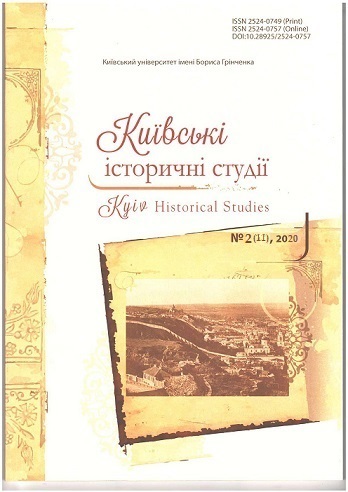THE PYLIAN BASILEIS ACCORDING TO THE TEXT OF THE JN SERIES
DOI:
https://doi.org/10.28925/2524-0757.2020.2.6Keywords:
basileus, qasireu, Jn series, linear B, Mycenaean civilizationAbstract
The activities of the basileis, who appear in Homer’s poems as tribal leaders, are associated with the organizing of handicraft production in the texts of linear B. Since the position of basileus, which appears before us for the first time in the Pylian and Knossos texts, continues to exist in the polis period, the study of the functions of the Achaean basileis will not only expand and deepen our knowledge of this position in the Mycenaean kingdoms of the second millennium, but will also allow us to reveal the transformational processes that this office underwent after the collapse of the palatial states of Greece and during the emergence of classical polis civilization. This article examines the Pylian texts of the Jn series, which record the basileis’ fulfillment of the function of managing (overseeing) the work of the smiths. The work is based on the so called combinatorial method, which provides in-depth study of the internal structure of texts as a fundamental stage of penetration into their content. Applying this method, the author recognizes four distinct sections in the document Jn 431: apekean smiths who have tarasija; apekean smiths, who do not have tarasija; apekean smiths of Potnia, who have tarasija; apekean smiths of Potnia, who do not have tarasija. This division allows us to conclude that the basileus Apiqota only supervises the work of the apekean smiths who have tarasija, and is not associated with the apekean smiths who do not have tarasija. Analasing the role played by the basileis in the Jn series in general and the functions that the basileus Apiqota performs in the text of Jn 431 in particular, and also based on the fact that the basis of basileis’ activity was concentrated in the qasirewija headed by them, the author concludes that the basileis were not in any way substantially or organically connected with the smiths, and the function of controlling their work was imposed on the basileis by the palace in certain individual cases (Jn 431, 691, 845) and played a secondary role in their activities.
Downloads
References
Carlier, P. (1995). Qa-si-re-u et qa-si-re-wi-ja [Qa-si-re-u and qa-si-re-wi-ja] (R. Laffineur, W.-D. Niemeier / Ed.). Politeia [in French].
Chadwick J., Killen J. T., Olivier J. P. (2012). The Knossos Tablets. Cambridge: Cambridge University Press [in English].
Killen, J. T. (2001). Some Thoughts on ta-ra-si-ja. Economy and Politics in the Mycenaean Palace States. Proceedings of a Conference held on 1–3 July 1999 in the Faculty of Classics, pp. 161–180, Cambridge [in English].
Lang, M. (1966). Jn Formulas and Groups. Hesperia, 35, 397–412 [in English].
Lejeune, M. (1961). Les forgerons de Pylos. Historia, 10.4, 409–434 [in French].
Montecchi, B. (2012). Wool-Spinning, Bronze-Working and the peculiarities of Mycenaean ta-ra-si-ja. (F. Serra / Ed.). Pasiphae, Rivista di filologia e antichita Agee [in English].
Nakassis, D. (2013). Individuals and Society in Mycenaean Pylos. Leiden and Boston: BRILL [in English].
Nikoloudis, S. (2006). The rawaketa, Ministerial Authority and Mycenaean Cultural Identity [The rawaketa, Ministerial Authority and Mycenaean Cultural Identity]. PhD Dissertation, Austin [in English].
Nosch, M.-L. (2006). More Thoughts on the Mycenaean ta-ra-si-ja System. (M. Perna / Ed.), Fiscality in Mycenaean and Near Eastern Archives [in English].
Olivier, J.-P. (2020). Del Freo M. The Pylos Tablets Transcribed: deuxième édition. Padova: Libreriauniversitaria.it edizioni Webster srl. [in French].
Palmer, L. (1963). The Interpretation of Mycenaean Greek Texts. Oxford: Clarendon Press; Toronto: Oxford University Press. [in English].
Polyakova, G. F. (1978). Socialno-politicheskaia struktura pilosskoho obshchestva (po dannym lineinoho pisma B). Moskva: Nauka [in Russian].
Smith, J. S. (1992–1993). The Pylos Jn series. Minos, 27–28, 167–259 [in English].
Ventris, M., Chadwick J. (1973). Documents in Mycenaean Greek, 2nd ed. Cambridge: Cambridge University Press [in English].
Published
How to Cite
Issue
Section
License
Copyright (c) 2020 Володимир Перещ

This work is licensed under a Creative Commons Attribution-NonCommercial-ShareAlike 4.0 International License.
Authors who publish in this journal retain the right of authorship of the work and give to the journal right of first publication of this work under the conditions of Creative Commons: Attribution-NonCommercial-ShareAlike 4.0 International (CC BY-NC-SA 4.0), which allows others freely distribute the work published with reference to the authors of the original work and the first publication of this magazine.














